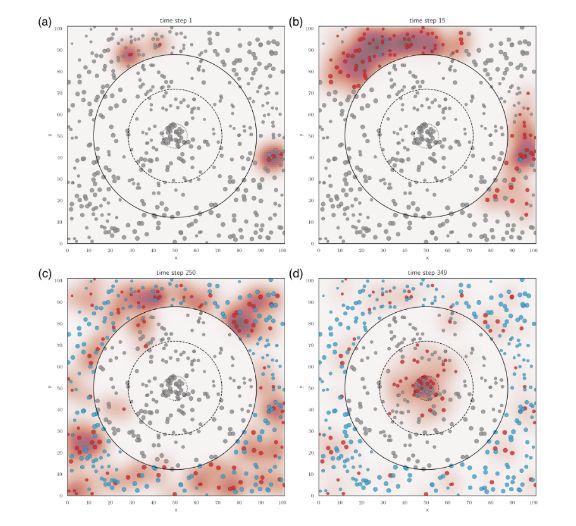
C. Brandon Ogbunu
@cbo.bsky.social
Scientist + Humanist + Pugilist.
70% Smoke. 30% Stack.
"Tip your hat; pop the chain; short Joe Louis; then wipe his nose with the hook. It's that simple." (c) Brother Naazim Richardson
https://linktr.ee/chike98
70% Smoke. 30% Stack.
"Tip your hat; pop the chain; short Joe Louis; then wipe his nose with the hook. It's that simple." (c) Brother Naazim Richardson
https://linktr.ee/chike98
3/5: Though the Bubble was built by an institution w/ nearly infinite resources (The NBA), we argue it can inspire a new strategy that can be broadly applied for infection control. To do this, we use concepts in theoretical disease ecology, agent-based simulations, + some analytical tools.

October 31, 2025 at 11:56 AM
3/5: Though the Bubble was built by an institution w/ nearly infinite resources (The NBA), we argue it can inspire a new strategy that can be broadly applied for infection control. To do this, we use concepts in theoretical disease ecology, agent-based simulations, + some analytical tools.
This classic dropped 30 years ago
Young folk can’t even sit through a full listen, let alone appreciate it, poor babies
Young folk can’t even sit through a full listen, let alone appreciate it, poor babies

October 23, 2025 at 12:22 PM
This classic dropped 30 years ago
Young folk can’t even sit through a full listen, let alone appreciate it, poor babies
Young folk can’t even sit through a full listen, let alone appreciate it, poor babies
4/5
Epistasis:
In the dinosaur "de-extinction" project, the scientists overlook epistasis, the non-additive interactions among genes and mutations. As a general rule, genome engineering efforts can be undermined by these non-additive, surprising interactions.
Epistasis:
In the dinosaur "de-extinction" project, the scientists overlook epistasis, the non-additive interactions among genes and mutations. As a general rule, genome engineering efforts can be undermined by these non-additive, surprising interactions.

October 14, 2025 at 12:49 PM
4/5
Epistasis:
In the dinosaur "de-extinction" project, the scientists overlook epistasis, the non-additive interactions among genes and mutations. As a general rule, genome engineering efforts can be undermined by these non-additive, surprising interactions.
Epistasis:
In the dinosaur "de-extinction" project, the scientists overlook epistasis, the non-additive interactions among genes and mutations. As a general rule, genome engineering efforts can be undermined by these non-additive, surprising interactions.
3/5
Pleiotropy:
Also, the novel’s scientists may have overlooked pleiotropy, the tendency of a single gene to affect multiple traits. Edit one locus for appearance, and you may alter behavior, physiology, or fitness. Even in fiction, we learn how genes operate in entangled, nonlinear systems.
Pleiotropy:
Also, the novel’s scientists may have overlooked pleiotropy, the tendency of a single gene to affect multiple traits. Edit one locus for appearance, and you may alter behavior, physiology, or fitness. Even in fiction, we learn how genes operate in entangled, nonlinear systems.

October 14, 2025 at 12:49 PM
3/5
Pleiotropy:
Also, the novel’s scientists may have overlooked pleiotropy, the tendency of a single gene to affect multiple traits. Edit one locus for appearance, and you may alter behavior, physiology, or fitness. Even in fiction, we learn how genes operate in entangled, nonlinear systems.
Pleiotropy:
Also, the novel’s scientists may have overlooked pleiotropy, the tendency of a single gene to affect multiple traits. Edit one locus for appearance, and you may alter behavior, physiology, or fitness. Even in fiction, we learn how genes operate in entangled, nonlinear systems.
2/5
Plasticity:
The novel highlights the concept of plasticity, or the capacity of genotypes to produce different phenotypes across environments.
The fictional project fails not (only) because of bad cloning, but from the mismatch between organism + environment.
Plasticity:
The novel highlights the concept of plasticity, or the capacity of genotypes to produce different phenotypes across environments.
The fictional project fails not (only) because of bad cloning, but from the mismatch between organism + environment.

October 14, 2025 at 12:49 PM
2/5
Plasticity:
The novel highlights the concept of plasticity, or the capacity of genotypes to produce different phenotypes across environments.
The fictional project fails not (only) because of bad cloning, but from the mismatch between organism + environment.
Plasticity:
The novel highlights the concept of plasticity, or the capacity of genotypes to produce different phenotypes across environments.
The fictional project fails not (only) because of bad cloning, but from the mismatch between organism + environment.
1/5
🦖 Michael Crichton’s Jurassic Park (1990) turns 35 in November. In a new preprint, I argue that it was a prescient meditation on evolutionary genetics, complexity, & control. I also examine analogous efforts of today (e.g. “de-extinction.")
Select points below:
ecoevorxiv.org/repository/v...
🦖 Michael Crichton’s Jurassic Park (1990) turns 35 in November. In a new preprint, I argue that it was a prescient meditation on evolutionary genetics, complexity, & control. I also examine analogous efforts of today (e.g. “de-extinction.")
Select points below:
ecoevorxiv.org/repository/v...

October 14, 2025 at 12:49 PM
1/5
🦖 Michael Crichton’s Jurassic Park (1990) turns 35 in November. In a new preprint, I argue that it was a prescient meditation on evolutionary genetics, complexity, & control. I also examine analogous efforts of today (e.g. “de-extinction.")
Select points below:
ecoevorxiv.org/repository/v...
🦖 Michael Crichton’s Jurassic Park (1990) turns 35 in November. In a new preprint, I argue that it was a prescient meditation on evolutionary genetics, complexity, & control. I also examine analogous efforts of today (e.g. “de-extinction.")
Select points below:
ecoevorxiv.org/repository/v...
1/5
Over the last 12 months, I've had the pleasure of serving as a the author of @undark.org 's "Selective Pressure" column, where I examine the intersection between science and culture.
A few highlights:
undark.org/group/select...
Over the last 12 months, I've had the pleasure of serving as a the author of @undark.org 's "Selective Pressure" column, where I examine the intersection between science and culture.
A few highlights:
undark.org/group/select...

July 7, 2025 at 12:14 PM
1/5
Over the last 12 months, I've had the pleasure of serving as a the author of @undark.org 's "Selective Pressure" column, where I examine the intersection between science and culture.
A few highlights:
undark.org/group/select...
Over the last 12 months, I've had the pleasure of serving as a the author of @undark.org 's "Selective Pressure" column, where I examine the intersection between science and culture.
A few highlights:
undark.org/group/select...
4/5
The results suggest that political identity is complex, and simple narratives for why people vote the way they do are missing something essential.
The 2024 election (the object of present/future analysis) further reflects this.*
* www.washingtonpost.com/opinions/202...
The results suggest that political identity is complex, and simple narratives for why people vote the way they do are missing something essential.
The 2024 election (the object of present/future analysis) further reflects this.*
* www.washingtonpost.com/opinions/202...

June 12, 2025 at 2:41 PM
4/5
The results suggest that political identity is complex, and simple narratives for why people vote the way they do are missing something essential.
The 2024 election (the object of present/future analysis) further reflects this.*
* www.washingtonpost.com/opinions/202...
The results suggest that political identity is complex, and simple narratives for why people vote the way they do are missing something essential.
The 2024 election (the object of present/future analysis) further reflects this.*
* www.washingtonpost.com/opinions/202...
3/5
We find that nearly 40% of cities deviate from the narrative. For example, cities like Knoxville and Spokane voted Republican with lower-than-expected levels of implicit racial bias, In contrast, Chicago, Albany, and Minneapolis (Democratic cities) exhibited higher-than-expected bias levels.
We find that nearly 40% of cities deviate from the narrative. For example, cities like Knoxville and Spokane voted Republican with lower-than-expected levels of implicit racial bias, In contrast, Chicago, Albany, and Minneapolis (Democratic cities) exhibited higher-than-expected bias levels.

June 12, 2025 at 2:41 PM
3/5
We find that nearly 40% of cities deviate from the narrative. For example, cities like Knoxville and Spokane voted Republican with lower-than-expected levels of implicit racial bias, In contrast, Chicago, Albany, and Minneapolis (Democratic cities) exhibited higher-than-expected bias levels.
We find that nearly 40% of cities deviate from the narrative. For example, cities like Knoxville and Spokane voted Republican with lower-than-expected levels of implicit racial bias, In contrast, Chicago, Albany, and Minneapolis (Democratic cities) exhibited higher-than-expected bias levels.
1/5
In a comment published in NPJ Complexity, SFI @sfiscience.bsky.social post-doc Andrew Stier and I ask a critical question:
"What is the relationship between voting patterns in American cities and implicit racial bias?"
We find that the story is...complicated.
www.nature.com/articles/s44...
In a comment published in NPJ Complexity, SFI @sfiscience.bsky.social post-doc Andrew Stier and I ask a critical question:
"What is the relationship between voting patterns in American cities and implicit racial bias?"
We find that the story is...complicated.
www.nature.com/articles/s44...

June 12, 2025 at 2:41 PM
1/5
In a comment published in NPJ Complexity, SFI @sfiscience.bsky.social post-doc Andrew Stier and I ask a critical question:
"What is the relationship between voting patterns in American cities and implicit racial bias?"
We find that the story is...complicated.
www.nature.com/articles/s44...
In a comment published in NPJ Complexity, SFI @sfiscience.bsky.social post-doc Andrew Stier and I ask a critical question:
"What is the relationship between voting patterns in American cities and implicit racial bias?"
We find that the story is...complicated.
www.nature.com/articles/s44...
25 Years ago, one of the greatest artists to ever live went to the essence.
Rest in Power, Christopher Lee Rios (1971 - 2000)
"Dead-in-the middle-of-little-Italy-little-did-we-know-that-we-riddled-two-middlemen-who didn't-do-diddly"
Rest in Power, Christopher Lee Rios (1971 - 2000)
"Dead-in-the middle-of-little-Italy-little-did-we-know-that-we-riddled-two-middlemen-who didn't-do-diddly"

May 7, 2025 at 5:28 PM
25 Years ago, one of the greatest artists to ever live went to the essence.
Rest in Power, Christopher Lee Rios (1971 - 2000)
"Dead-in-the middle-of-little-Italy-little-did-we-know-that-we-riddled-two-middlemen-who didn't-do-diddly"
Rest in Power, Christopher Lee Rios (1971 - 2000)
"Dead-in-the middle-of-little-Italy-little-did-we-know-that-we-riddled-two-middlemen-who didn't-do-diddly"
From our 2023 paper (Klein et al.), not about genomics. The statement wasn't very hard to write or include. And it is far from ideal -- it's the least one can do. A technical consideration.

February 20, 2024 at 11:44 PM
From our 2023 paper (Klein et al.), not about genomics. The statement wasn't very hard to write or include. And it is far from ideal -- it's the least one can do. A technical consideration.

